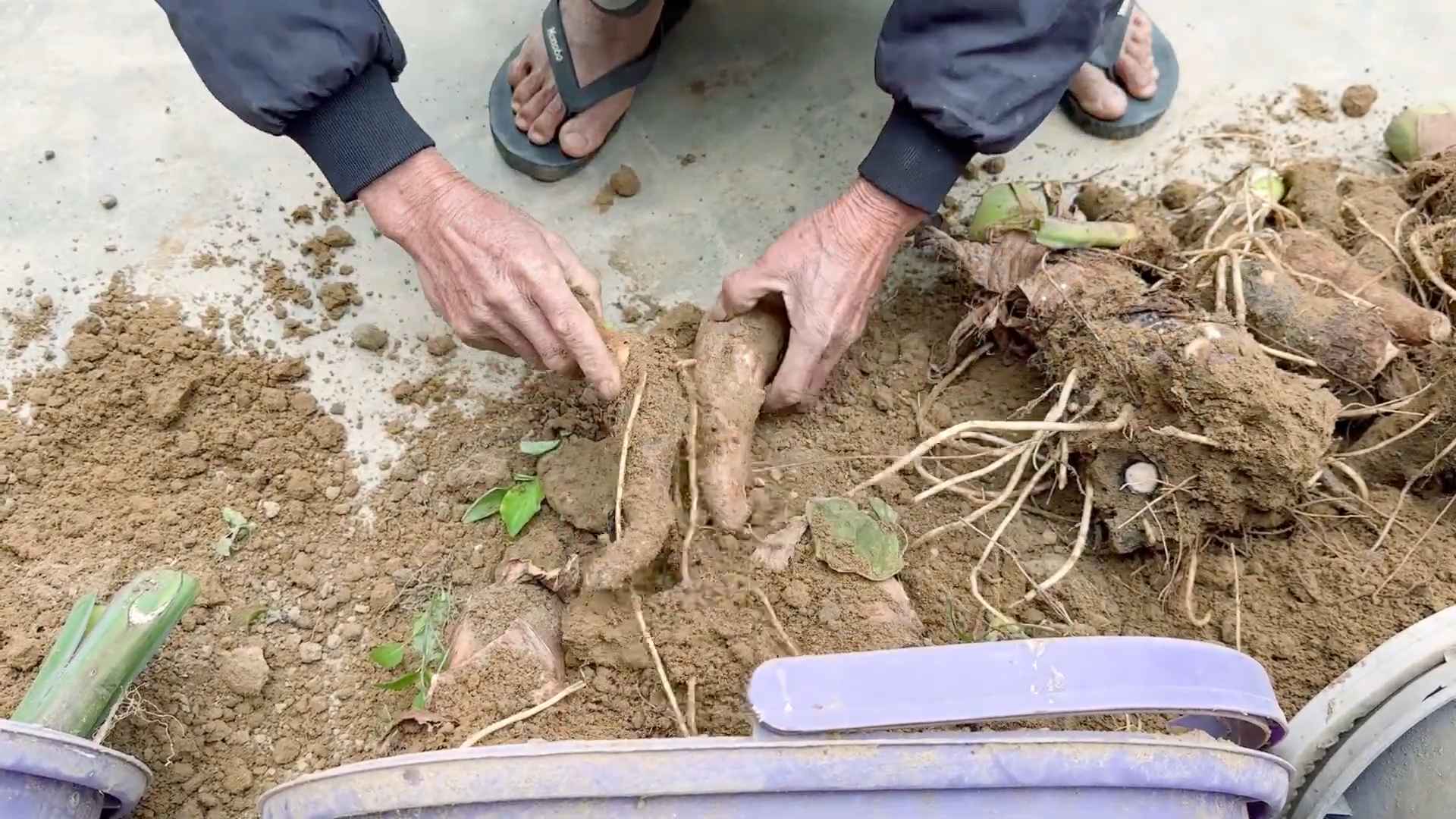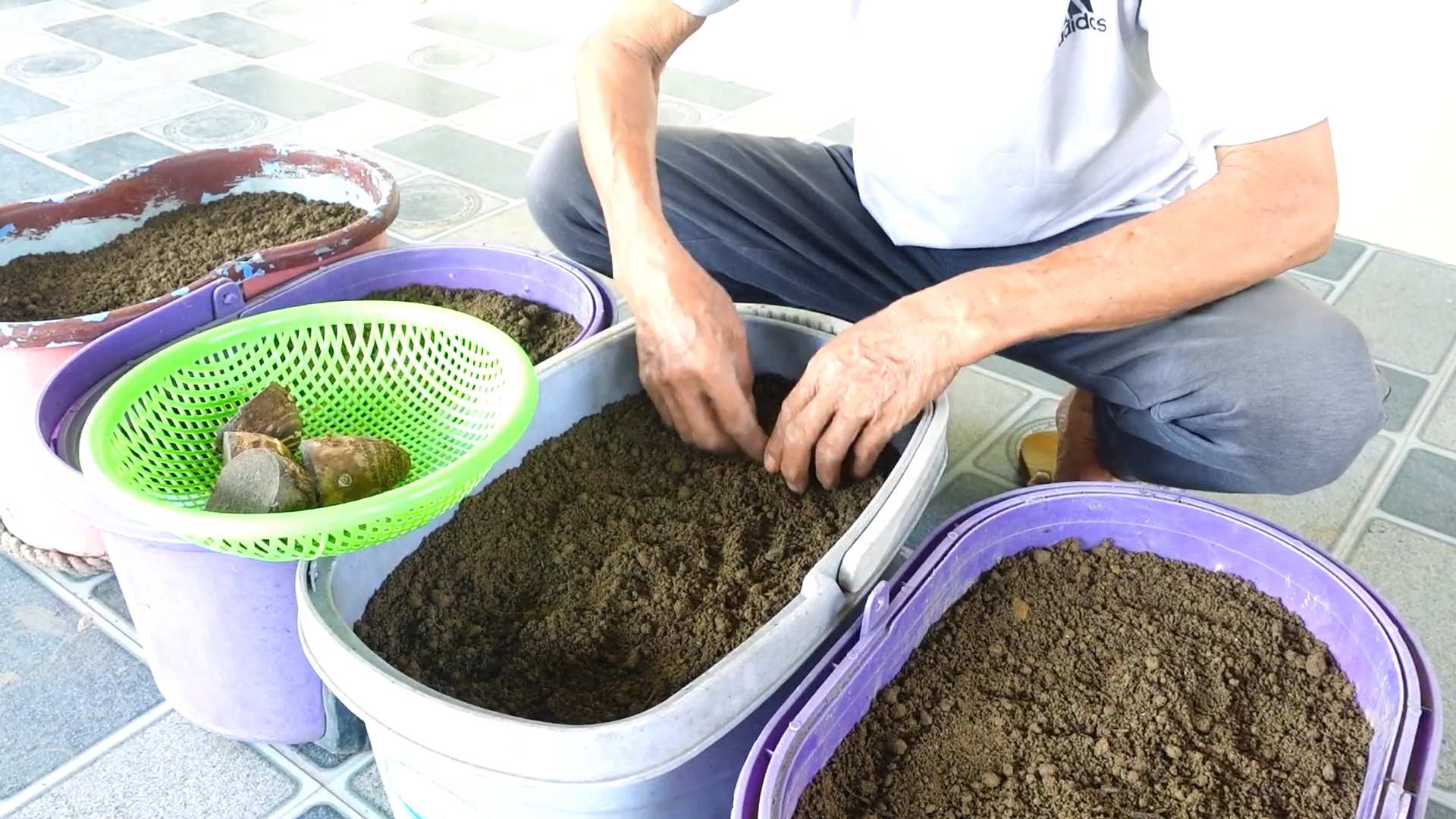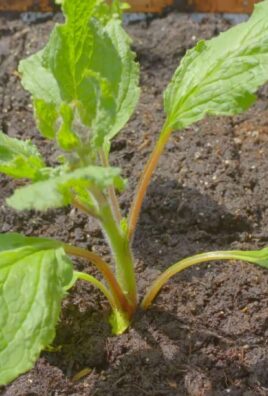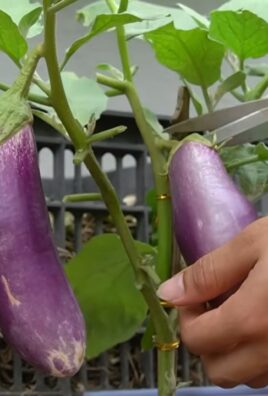Grow Taro at Home? Absolutely! Imagine harvesting your own creamy, nutty-flavored taro root, right from your backyard. It’s easier than you think, and I’m here to guide you through the process with some simple DIY tricks. For centuries, taro has been a staple food in many cultures, particularly in the Pacific Islands and Asia. It’s more than just a food source; it’s deeply intertwined with traditions, ceremonies, and family gatherings. Think of poi in Hawaii or the various taro-based dishes enjoyed across Southeast Asia – all stemming from this amazing plant.
But why should you bother to grow taro at home? Well, for starters, it’s incredibly rewarding to cultivate your own food. Plus, store-bought taro can sometimes be hard to find or quite expensive. More importantly, growing your own allows you to control the growing conditions, ensuring you have access to fresh, organic taro free from harmful pesticides. In this article, I’ll share some of my favorite DIY hacks and tips to help you successfully cultivate taro, even if you have limited space or gardening experience. Get ready to roll up your sleeves and discover the joy of growing your own taro!

Growing Taro at Home: A Beginner’s Guide
Hey there, fellow plant enthusiasts! Ever thought about growing your own taro? It might seem a little exotic, but trust me, it’s totally doable, even if you don’t have a sprawling garden. I’m going to walk you through everything you need to know to cultivate this fascinating plant right in your own home. Get ready to get your hands dirty!
Choosing Your Taro Variety
First things first, let’s talk taro varieties. There are tons of different types, each with its own unique characteristics. Some are better suited for growing in pots, while others thrive in larger garden beds. Here’s a quick rundown of some popular choices:
* Bun Long: This is a common variety, known for its large, heart-shaped leaves and relatively easy cultivation. It’s a great option for beginners.
* Dasheen: Another widely grown variety, Dasheen produces large corms (the edible part of the taro plant). It’s a bit more demanding in terms of space, so keep that in mind.
* Eddoe: Eddoe produces smaller corms and is often grown for its leaves as well. It’s a good choice if you’re limited on space.
* Black Magic: If you’re looking for something visually striking, Black Magic taro has dark purple to almost black leaves. It’s a bit more sensitive to cold, so keep that in mind if you live in a cooler climate.
I recommend starting with Bun Long or Eddoe if you’re new to taro growing. They’re relatively forgiving and will give you a good feel for the plant’s needs.
Gathering Your Supplies
Okay, now that you’ve chosen your variety, let’s gather the necessary supplies. You’ll need:
* Taro Corm or Seedling: You can find these at your local nursery or online. Make sure the corm is firm and healthy-looking. If you’re starting from a seedling, choose one that’s vibrant and free from pests.
* Pot or Container: Choose a pot that’s at least 12 inches in diameter and 12 inches deep. Taro needs room for its roots to grow. Make sure the pot has drainage holes.
* Potting Mix: Use a well-draining potting mix that’s rich in organic matter. I like to use a mix of peat moss, perlite, and compost.
* Water: Taro loves water, so make sure you have a good supply.
* Fertilizer: A balanced fertilizer (like 10-10-10) will help your taro plant thrive.
* Optional: Mulch (like straw or wood chips) to help retain moisture in the soil.
Planting Your Taro
Alright, let’s get planting! This is the fun part.
1. Prepare the Pot: Fill your pot with the potting mix, leaving a few inches of space at the top.
2. Plant the Corm or Seedling: If you’re planting a corm, place it about 2-3 inches deep in the soil, with the pointed end facing up. If you’re planting a seedling, gently remove it from its container and plant it at the same depth it was growing in before.
3. Water Thoroughly: Water the soil until it’s evenly moist. Don’t overwater, but make sure the soil is well-saturated.
4. Add Mulch (Optional): If you’re using mulch, spread a thin layer around the base of the plant. This will help retain moisture and suppress weeds.
Caring for Your Taro Plant
Now that your taro is planted, it’s time to provide it with the care it needs to thrive. Here’s what you need to know:
* Sunlight: Taro loves bright, indirect sunlight. Avoid placing it in direct sunlight, as this can scorch the leaves. A spot near a window that receives morning sun is ideal.
* Watering: Taro needs consistently moist soil. Water it regularly, especially during hot weather. Check the soil moisture daily and water when the top inch feels dry to the touch. Don’t let the soil dry out completely.
* Humidity: Taro thrives in humid environments. If you live in a dry climate, you can increase humidity by misting the leaves regularly or placing the pot on a tray filled with pebbles and water.
* Fertilizing: Fertilize your taro plant every 2-3 weeks during the growing season (spring and summer) with a balanced fertilizer. Follow the instructions on the fertilizer package.
* Temperature: Taro prefers warm temperatures, ideally between 65°F and 85°F (18°C and 29°C). Protect it from frost and cold drafts.
* Pest Control: Keep an eye out for pests like aphids, spider mites, and mealybugs. If you spot any pests, treat them with insecticidal soap or neem oil.
* Pruning: Remove any yellowing or dead leaves to keep your taro plant healthy and attractive.
Troubleshooting Common Problems
Even with the best care, you might encounter some problems along the way. Here are a few common issues and how to address them:
* Yellowing Leaves: This could be a sign of overwatering, underwatering, or nutrient deficiency. Check the soil moisture and adjust your watering accordingly. If the soil is consistently moist, you might be overwatering. If the soil is dry, you need to water more frequently. You can also try fertilizing your plant to provide it with the nutrients it needs.
* Brown Leaf Tips: This is often caused by dry air. Increase humidity by misting the leaves or placing the pot on a tray filled with pebbles and water.
* Stunted Growth: This could be due to insufficient sunlight, poor soil, or nutrient deficiency. Make sure your taro plant is getting enough sunlight and that the soil is well-draining and rich in organic matter. You can also try fertilizing your plant.
* Pests: As mentioned earlier, keep an eye out for pests and treat them promptly with insecticidal soap or neem oil.
Harvesting Your Taro
The moment you’ve been waiting for! Harvesting your taro.
Harvesting time depends on the variety and your growing conditions, but generally, you can harvest taro corms after about 7-12 months. The leaves will start to turn yellow and die back when the corms are ready to harvest.
1. Loosen the Soil: Gently loosen the soil around the base of the plant.
2. Carefully Dig Up the Corms: Use a garden fork or shovel to carefully dig up the corms. Be careful not to damage them.
3. Clean the Corms: Wash the corms thoroughly to remove any dirt or debris.
4. Cure the Corms (Optional): Curing the corms can improve their flavor and storage life. To cure them, place them in a warm, dry place for a few days.
Enjoying Your Homegrown Taro
Now that you’ve harvested your taro, it’s time to enjoy the fruits (or rather, corms) of your labor! Taro corms can be cooked in a variety of ways, including boiling, steaming, baking, and frying. They have a slightly sweet, nutty flavor and are a staple food in many cultures.
Important Note: Taro corms contain calcium oxalate crystals, which can cause irritation if eaten raw. Always cook taro thoroughly before eating it.
Here are a few ideas for using your homegrown taro:
* Taro Chips: Slice the corms thinly and bake or fry them into crispy chips.
* Taro Mash: Boil or steam the corms and mash them with butter, milk, and seasonings.
* Taro Stew: Add diced taro to your favorite stew or soup.
* Poi: In Hawaiian cuisine, taro is traditionally pounded into a starchy paste called poi.
Propagating Taro
Want to expand your taro collection? You can easily propagate taro from corms or cuttings.
* From Corms: Simply plant a small corm in a pot of potting mix, as described earlier.
* From Cuttings: Take a cutting from a healthy taro stem, making sure it has at least one node (the point where a leaf grows). Place the cutting in water until roots develop, then plant it in a pot of potting mix.
Final Thoughts
Growing taro at home can be a rewarding experience. It’s a fascinating plant to watch grow, and you’ll be rewarded with delicious and nutritious corms. With a little care and attention, you can successfully cultivate taro in your own home, no matter where you live. So, go ahead and give it a try! You might just surprise yourself with your green thumb. Happy growing!

Conclusion
So, there you have it! Growing taro at home is not only achievable but also incredibly rewarding. Forget the expensive grocery store prices and the uncertainty of where your produce comes from. With a little patience and the right approach, you can cultivate your own supply of this delicious and nutritious root vegetable right in your backyard or even indoors.
This DIY taro growing trick is a must-try for several reasons. First and foremost, it empowers you to take control of your food source. You know exactly what goes into growing your taro, ensuring it’s free from harmful pesticides and chemicals. Secondly, it’s a fantastic way to connect with nature and learn about the life cycle of plants. There’s something truly special about nurturing a plant from a small corm to a thriving, leafy specimen. Finally, it’s a cost-effective solution. Once you have your initial corm, you can propagate new plants from the offshoots, creating a sustainable supply of taro for years to come.
But the fun doesn’t stop there! Feel free to experiment with different varieties of taro to discover your favorite flavor profiles. Some varieties are better suited for boiling, while others excel in baking or frying. You can also explore different growing mediums, such as hydroponics, for a unique and efficient approach. Consider adding companion plants like basil or marigolds to deter pests and enhance the overall health of your taro plants.
Don’t be afraid to get your hands dirty and embrace the learning process. Growing taro at home is a journey, and there will be challenges along the way. But with perseverance and a little bit of research, you’ll be rewarded with a bountiful harvest of fresh, homegrown taro.
We wholeheartedly encourage you to try this DIY taro growing trick. It’s a simple, sustainable, and satisfying way to enjoy this versatile vegetable. Once you’ve experienced the joy of harvesting your own taro, we’re confident you’ll be hooked!
And most importantly, we want to hear about your experiences! Share your successes, your challenges, and any tips or tricks you discover along the way. Let’s create a community of home taro growers and learn from each other. Post photos of your taro plants, share your favorite taro recipes, and let us know what worked best for you. Together, we can unlock the full potential of growing taro at home and enjoy the many benefits it has to offer. So, grab a taro corm, get your hands dirty, and start growing!
Frequently Asked Questions (FAQ)
What is taro, and why should I grow it?
Taro (Colocasia esculenta) is a starchy root vegetable that is a staple food in many cultures around the world, particularly in the Pacific Islands, Asia, and Africa. It’s a versatile ingredient that can be boiled, baked, fried, or steamed. Taro is also a good source of fiber, vitamins, and minerals. Growing taro at home allows you to have a fresh, sustainable source of this nutritious vegetable, free from pesticides and other harmful chemicals. Plus, it’s a rewarding and educational experience!
What kind of climate is best for growing taro?
Taro thrives in warm, humid climates. It prefers temperatures between 70°F and 90°F (21°C and 32°C). It also needs plenty of moisture, so regular watering or a consistently damp environment is crucial. If you live in a cooler climate, you can still grow taro indoors or in a greenhouse, providing you can maintain the necessary temperature and humidity levels.
Where can I get taro corms to start growing?
You can often find taro corms at Asian grocery stores or nurseries that specialize in tropical plants. Make sure the corms are firm and healthy-looking, without any signs of rot or disease. You can also try ordering them online from reputable seed suppliers.
How do I prepare the taro corm for planting?
Before planting, you can sprout the taro corm by placing it in a container of water, with the top portion exposed to air. Keep the water level consistent and change it every few days. Once you see roots and shoots emerging, you can plant the corm in soil.
What kind of soil is best for growing taro?
Taro prefers rich, well-draining soil that is high in organic matter. A mixture of potting soil, compost, and peat moss is a good option. The soil should also be slightly acidic to neutral (pH 6.0-7.0).
How often should I water my taro plants?
Taro needs consistent moisture to thrive. Water your plants regularly, keeping the soil consistently damp but not waterlogged. In hot weather, you may need to water them daily. If you’re growing taro in a container, make sure it has drainage holes to prevent root rot.
How much sunlight does taro need?
Taro prefers partial shade, especially during the hottest part of the day. Too much direct sunlight can scorch the leaves. If you’re growing taro indoors, place it near a bright window but avoid direct sunlight.
How long does it take for taro to mature?
Taro typically takes 6-12 months to mature, depending on the variety and growing conditions. You’ll know it’s ready to harvest when the leaves start to turn yellow and die back.
How do I harvest taro?
To harvest taro, carefully dig around the plant and lift the corm out of the soil. You can also harvest the smaller cormels (side shoots) that grow around the main corm.
Are taro leaves edible?
Yes, taro leaves are edible, but they must be cooked thoroughly to remove calcium oxalate crystals, which can cause irritation. Boiling or steaming the leaves for at least 30 minutes will break down these crystals. Taro leaves are often used in dishes like laulau (Hawaiian steamed taro leaves with pork or fish).
What are some common pests and diseases that affect taro?
Common pests that can affect taro include aphids, spider mites, and snails. Diseases include root rot and leaf blight. You can control pests with insecticidal soap or neem oil. To prevent diseases, ensure good drainage and avoid overwatering.
Can I grow taro in a container?
Yes, you can grow taro in a container, as long as it’s large enough to accommodate the plant’s root system. Choose a container that is at least 12 inches deep and wide. Make sure the container has drainage holes to prevent root rot.
How do I store taro after harvesting?
Store taro corms in a cool, dry, and well-ventilated place. They can last for several weeks if stored properly. Avoid storing them in the refrigerator, as this can cause them to become mushy.
Is taro poisonous if eaten raw?
Yes, taro contains calcium oxalate crystals, which can cause irritation if eaten raw. It’s essential to cook taro thoroughly before consuming it to break down these crystals.
What are some ways to cook and eat taro?
Taro can be cooked in many ways, including boiling, baking, frying, and steaming. It can be used in soups, stews, curries, and desserts. Some popular taro dishes include poi (Hawaiian pounded taro), taro chips, and taro bubble tea.




Leave a Comment